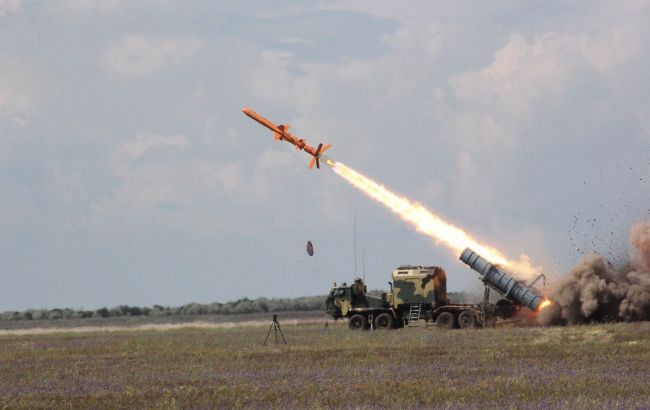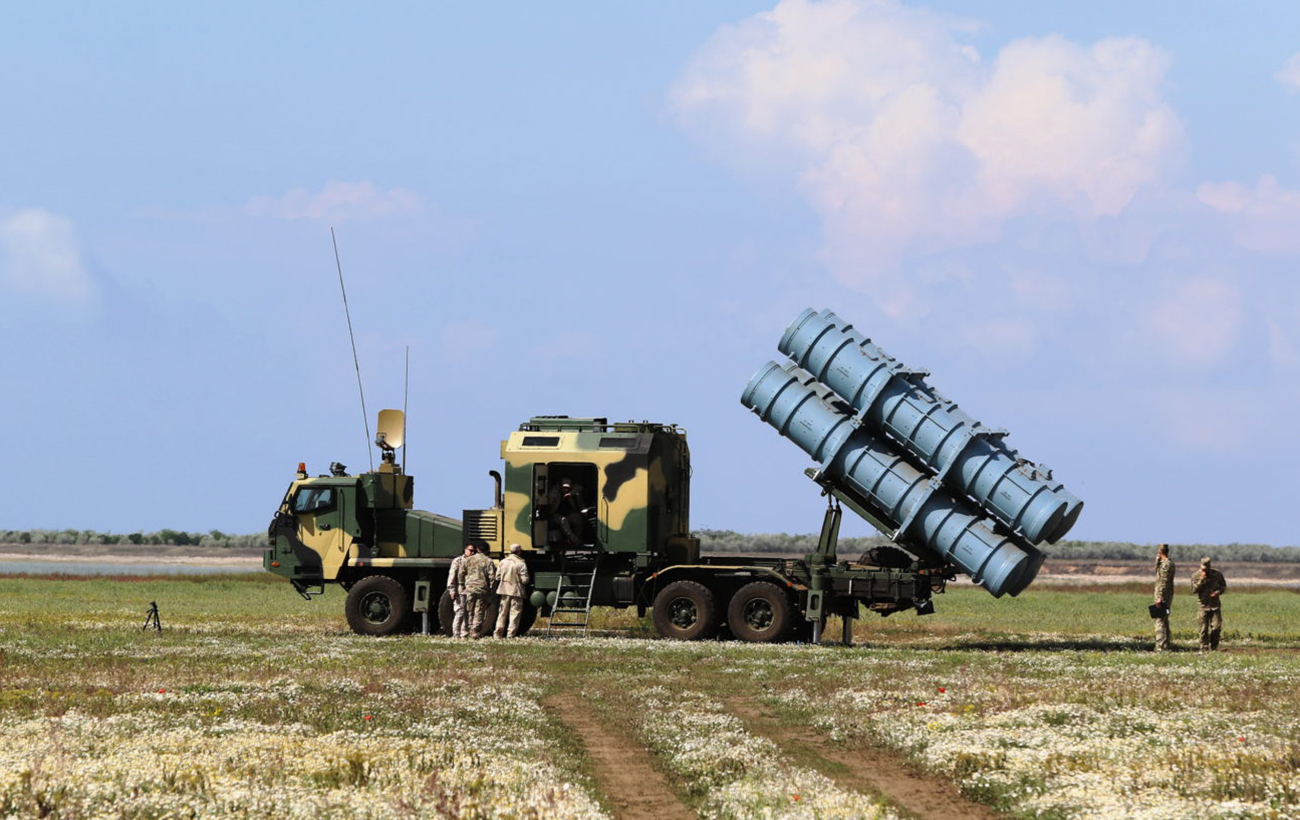Neptune back in action - Can latest Ukrainian missile reach Moscow?
 Photo: Ukraine has adapted the Neptune missile for strikes against ground targets (mil.gov.ua)
Photo: Ukraine has adapted the Neptune missile for strikes against ground targets (mil.gov.ua)
For strikes against Russian ground targets, Ukraine has begun using long-range missiles of its own design. Experts lean toward the belief that this is a specially modified version of the anti-ship Neptune missile.
Specific features of this missile and what it is capable of are analyzed in the RBC-Ukraine material.
Ukrainian Neptune
This is an anti-ship guided missile developed by the Kyiv Design Bureau "Luch" ("Ray"). In 2020, the coastal complex RK-360MC Neptune with the R-360 missile was adopted for service.
The missile has a warhead of 150 kg and is intended for the destruction of ships with a displacement of up to 5,000 tons.
Its range is up to 300 km. It has a subsonic speed (900 km/h) and flies at an altitude of a few meters above sea level. The missile is capable of maneuvering during flight.
It can be launched from ship-based, ground-based, and airborne platforms. The ground-based complex RK-360MC includes a command post, a launch installation, and a transport-charging vehicle.
The length of the missile with the accelerator is about 5 meters, the launch weight is about 870 kg, and it has a cross-shaped folding wing.
The warhead is a fragmentation-impact type, activated by a contact fuse or remotely (non-contact sensors). It was also reported in 2021 that the technology of vacuum-fragmentation filling of the warhead had been implemented, significantly enhancing its penetrating capability.
The homing head has a very wide field of view of ±60 degrees, is capable of capturing a target at a distance of 50 km, and is resistant to radar interference. The booster engine is a modified version taken from the C-125 anti-aircraft missile. After reaching the necessary acceleration, the main turbojet engine, manufactured by the "Motor Sich" plant, is engaged.
The first confirmed combat use was in April 2022 during the full-scale Russian invasion. At that time, two Neptune missiles sank the missile cruiser "Moskva," the flagship of the Russian Black Sea Fleet.
Neptune targeting ground targets
In June 2023, it became known that Ukraine approved a program to develop missiles with a range of 1000 km. Defense Minister Oleksii Reznikov spoke about very promising prospects and mentioned the successful use of Neptune against a Russian cruiser.
Talks about the possible modification of Neptune for strikes against ground targets began in August. It should be noted that there is no official confirmation of this information.
In the western part of Crimea, on Cape Tarkhankut, explosions were heard on August 23, with reports of strikes on a Russian military unit. Military intelligence reported the destruction of the S-400 Triumph air defense system and provided video evidence. It was later clarified that, in addition to the S-400, three S-300 launchers were destroyed or damaged.
Secretary of the National Security and Defense Council Oleksii Danilov revealed that the latest missile was used to target the S-400 at Tarkhankut, describing it as "absolutely flawless." However, he did not disclose what type of missile it was or whether it was a modification of existing missiles. He emphasized that its development began in 2020.
In a comment to RBC-Ukraine, military expert Vladyslav Seleznov stated that the S-400 in this part of Crimea had been a nuisance to operators of UAVs and kamikaze drones, detecting and shooting down Ukrainian drones.
"Thanks to high-tech missile weapons based on the Neptune missile, it was possible to destroy not only the installation but also the loaded missiles, part of the operators, and servicing personnel," he said.
A few days after Danilov's statement, the American project The War Zone quoted an unnamed representative of the Ukrainian Ministry of Defense as saying that the S-400 system in the area of the village of Olenivka on Cape Tarkhankut "was 100 percent carried out by a modified Neptune."
On August 31, Oleksii Danilov sparked further interest with a new video. He posted footage of a test of an unknown missile, ironically accompanying it with the lyrics of the song "Zhdyot Sevastopol, zhdyot Kamchatka, zhdyot Kronstadt" (Sevastopol is waiting, Kamchatka is waiting, Kronstadt is waiting) by the Russian band Lyube, considered a favorite of Russian dictator Vladimir Putin.
Analysts from the Defense Express portal have noticed that the missile in the video has at least one common structural element with the Neptune, specifically the launch booster. Additionally, the launch installation has some similarities to the RK-360MC system. Although it may have a different chassis or placement, for example, on a trailer.
Moreover, the fact that these tests were conducted at night could indicate the use of either an inertial guidance system or a combined one. Overall, based on indirect signs, the missile in the video appears to fit the possible description of the Neptune for ground targets.
Features of the new Neptune
As reported by The Drive, an unnamed Ukrainian official mentioned in April 2023 that work was underway on a new version of the missile. According to him, a different guidance system was needed, which required specific chips, but the system was nearing completion.
In August, the same official confirmed the development of a GPS guidance system that guides the missile to a specific location. Then, the infrared self-guidance head identifies the target based on a preloaded image and attacks it. If the missile cannot hit the target, the attack is terminated.
The Drive considers this a significant leap in Ukrainian capabilities, especially because, with this technology, it's difficult to detect the missile at the terminal stage, and it cannot be jammed by electronic warfare means, as the self-guidance heads are passive in nature.
Experts do not rule out the possibility that Ukraine may have acquired image recognition technologies for target guidance like DSMAC or automatic target recognition (ATR). Currently, such guidance systems are used by cruise missiles like Storm Shadow and SCALP-EG.
Therefore, the Neptune variant could be a repetition of the anti-ship RGM-84 Harpoon, on the basis of which, after modification with an infrared passive seeker, the AGM-84E SLAM missile for ground targets was developed.

Photo: A modification of the Neptune can be launched from the existing ground complex RK-360MC (armyinform.com.ua)
It is possible that the Ukrainian adaptation uses a different guidance principle, specifically, GPS coordinates. However, The Drive, after a detailed description of Neptune's capabilities, considers this unlikely. Moreover, the Russians actively employ powerful electronic warfare systems that disrupt GPS, which would negatively impact the effectiveness of HIMARS missiles.
Some other features of the Ukrainian innovation are revealed as well. It is reported that the missile is launched from the same installation as the anti-ship version but has a range of about 400 km and carries around 350 kg of explosives.
"If this is true, it will be the longest-range and most powerful strike missile created by Ukraine. But we have no way to independently verify these claims," The Drive added.
At the same time, there are drawbacks. Firstly, the supersonic flight of the missile may be vulnerable to modern Russian air defense systems. Secondly, there are very few of them, as according to a Ukrainian source, only about 20 units were produced in August.
In a recent interview, President Volodymyr Zelenskyy confirmed that Ukraine has increased the production of Neptunes.
Will the new Neptune reach Moscow?
On conditions of anonymity, a Ukrainian official told The Drive that Zelenskyy's statement is likely related to the production of the "surface-to-surface" version.
In his opinion, the ability to attack Moscow will likely be realized in the near future. This would increase discomfort in the Russian capital, which previously suffered drone strikes. To increase the missile's flight range to approximately 800 km from the Ukrainian border, the fuel compartment might be enlarged, and the combat load reduced.
"This will increase the range and allow for an attack on Moscow. It will happen," the source added.
It is expected that an attack on a specific target in Moscow, such as a fuel facility, could impact logistics and exert significant psychological pressure on the city, which has not experienced such destruction as Ukraine has.
However, questions remain about how many of these missiles Ukraine can produce and how quickly. If Ukraine receives assistance from allies, it could help in all respects. For now, we have to wait to see where the modified Neptune will show itself next.
Planes in Pskov - work of the Neptune?
On the night of August 30, a massive attack was carried out on Russian territory. One of the targets was the Russian Kresty airfield near Pskov, during which four Il-76 military transport planes were destroyed, and two more could have been damaged.
It should be noted that the distance from the Ukrainian border to this airfield is about 700 km. A few days after the attack, Volodymyr Zelenskyy announced the successful use of long-range weaponry at such distances.
Defense Express analysts emphasize that if we are talking about the means of attack, the version with the modernized Neptune is unlikely, as the stated range is up to 400 km. Therefore, it is obvious that the attack on Pskov was carried out by drones.
At the same time, they noted that at the Engels airfield near Saratov (approximately 600 km from the Ukrainian border), the Russians "protected" their strategic aviation with car tires.
Perhaps this decision can be explained by the features of the Neptune modification, which uses an infrared self-guidance system with a thermal imaging image for target search and acquisition based on a preloaded image.
Tires on airplanes could lead to changes in the thermal imaging signature of the target. The Russians hope that during the flight, the self-guidance head of the Ukrainian missiles will not find the target's preset contour in its memory, which would lead to the termination of the attack.
Western experts' thoughts
Western experts tend to believe that Ukraine has adapted the anti-ship missile Neptune for strikes against ground targets.
According to Ian Williams, a deputy director of the Missile Defense Project at CSIS (Washington), this is part of Ukraine's efforts to enhance its long-range capabilities.
"In a perfect world, land-attack missions are not the best use for modern anti-ship missiles, which are specially designed to sink heavily armored warships at sea. But Ukraine is facing a real deficit in deep strike systems," he is quoted by Newsweek.
The strike on the S-400 air defense system at Cape Tarkhankut demonstrated that the Ukrainian side is capable of using these missiles for ground attacks and posing a threat to Russian facilities in the rear. The August attack proves that Ukraine has high-quality intelligence, and the Neptune missiles can approach Russian-controlled territory discreetly, according to Sidharth Kaushal, a Research Fellow at the Royal United Services Institute (London).
In his opinion, one of the probable differences between the ground and anti-ship variants of the Neptune is the guidance system that uses homing heads, allowing it to overcome obstacles and attack the target.

